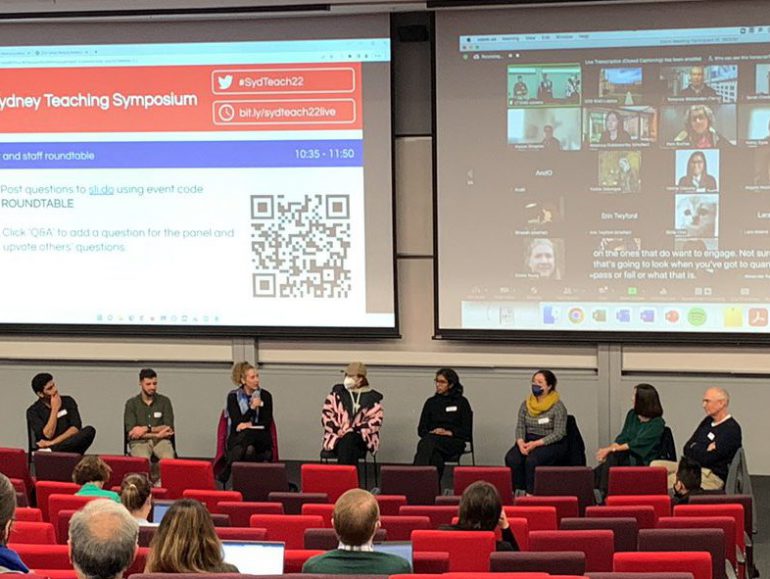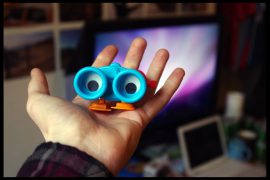It’s the middle of 2022 and we’ve had two and a half very strange years at Sydney. Two and a half years of figuring out how to learn and teach in a liminal space, caught between everything we knew to be true about tertiary education and a future that isn’t quite clear. One thing that does seem to increasingly make sense in this space is the feeling that connection and belonging, between all of us, is more important than ever before. It’s something that’s been key for many of us, both students and teachers, in getting through a very difficult period. True connection and belonging is intricately tied to authenticity, represented by the Sydney core pedagogical principle of ‘Being human‘. The 2022 Sydney Teaching Symposium seemed a great moment to sit down and discuss this as equals – to be human together.
In this article we present generously-contributed key insights from our student and staff roundtable, with some suggestions about how to make change together. It’s important that we note that we do not consider the suggestions proffered to be a one-size-fits-all solution, rather we advocate for continual reflection and dialogue in order to work towards a mutual understanding about how to learn and teach well together.
This article was co-contributed by members of the staff and student roundtable: Aditya Nair, Habib Salem, Mac Walker, Waner Zhangguan, Yasyika Alegesam, Janet Cheung, Janine Coupe, and Tim Fisher.
1 – Redefine (dis)connection
Our first request of the group was to comment on the all-too-familiar sight of the tweets that pop up on #AcademicTwitter towards the end of each semester featuring empty lecture theatres, with an expressed hope that students are watching online. All participants expressed a bit of sadness about this, and empathy for teachers who find themselves lecturing to seats rather than people. This began a productive discussion about what it means for students to be present and committed to their studies, with participants also reflecting on the unique opportunity face-to-face class time offers to connect with teachers and fellow students.
Participants raised an interesting point about how changing modes of engagement in tertiary education mirror changes happening in the world of work as a result of the COVID-19 pandemic more broadly; online spaces are being utilised more effectively and many people are becoming more comfortable with them as the default. Another participant commented on the flexibility that online delivery of teaching offers, that it can be both convenient and accessible to the many students in our cohorts who have significant responsibilities outside of their studies; caring, working, etc. Our lecture theatres may not be full but that doesn’t mean learning isn’t happening, and participants weighed in on how the online space can be utilised to build great connection; using polls, using the chat, all engaging students in new ways.
In our generation a lot of connections are formed virtually over social media, and what may be perceived as disconnection because it’s not in person may actually be a much wider form of connection
2 – Connect intentionally
It was clear from the first discussion that while ways of connecting are slowly shifting, connection remains core to creating a sense of belonging at Sydney, and thus to student success. One student participant remarked that they felt most motivated to attend classes when teachers made a concerted effort to build connective value into all of their interactions; to spend time chatting with students, and to allow space for students to chat with each other. Another student participant commented that in their work as an advisor many students they have talked to, especially new students joining us from secondary studies, are tempted to let their participation and motivation slip due to not seeing the importance of joining in on live, if online, interactions. Staff participants discussed a worrying increase in students not participating both in key contact hours and assessment tasks.
From these comments we identified two key points; that communicating the importance of participation is key, and that building moments to connect as people is just as important to student success as content delivery. It’s tempting to think it obvious that if something is timetabled students will see it as important and participate in it, but increasingly it seems that we need to ensure we’re demonstrating not only the importance, but the value of participation. Sometimes we may need to give students both a reason and an excuse to set aside the time to participate given their many competing priorities, and so communication about the value and importance of teaching activities becomes key. One staff participant highlighted their success with thinking outside the classroom box by dedicating time to a workshop held in the Chau Chak Wing Museum in order to build connection with the wider context of their subject, and also for students to build connection with each other. While building connection into a class will look different in every situation, humanising teaching and ensuring that we are building relevance to the outside world wherever possible is a great start.
3 – Co-design for success
Throughout the roundtable, student participants highlighted a number of key moments where they felt particularly connected to the University through their teachers, highlighting a need for teachers to reach out and work towards solutions together wherever possible. One student shared a story of working directly with a teacher to build a strategy to support their success in a unit of study while managing flare-ups from a chronic health condition. The positive impact on this student of such a caring collaboration was apparent, and doing this with an entire cohort – asking them about their interests in the subject, learning likes and dislikes, and forming open communication channels whereby students and teachers work together to make each unit meaningful and successful – leads to positive impacts for all. Another student noted the benefits to their learning of proactive design which engages students in thoughtful and varied ways throughout a semester; using quizzes, polls, videos, Q&A sessions, etc., allowing both choice and different means of engagement, and encouraging students to actively construct their own learning. Building in such flexibility aligns with the Universal Design principle of designing to the edges rather than the average, and results in greater opportunity for all. A strong thread throughout the responses given during the roundtable was the importance of offering options for engagement wherever possible; even with just five students present it was hard to find consensus on many things!
4 – Utilising the power of data
It’s no secret that, in general, students who are more engaged with their studies are more likely to succeed in them, but a theme emerged in our roundtable about the role of data to help us understand our students and how they’re engaging. Above we’ve mentioned a number of qualitative approaches endorsed by both student and staff participants for designing meaningful learning experiences and adding quantitative data, combined with our own experiences as teachers, offers great possibilities. One staff participant spoke of looking into their discussion board analytics at the end of semester and realising with astonishment that this space, carefully designed for high-quality interactions among staff and students, and for the communication of important unit information, had never been accessed by 20 percent of enrolled students. This information presents an opportunity to look further into what’s going on with those students, in order to design strategies to support them in subsequent semesters. Similarly, evaluative data on teaching effectiveness can also be helpful and we look forward to having more opportunities to gather and learn more from it in the future.
5 – Be human
Reflecting on our central theme of ‘Being human’, our roundtable participants shared moments when they felt particularly connected and supported.
- One student participant shared a moment where they disclosed their chronic health condition and were surprised to find out that their tutor shared the same diagnosis. This ‘real’ moment, where both felt comfortable chatting about how their life outside of the classroom affected things inside it, left the student feeling cared for, that they had an advocate, and that their experience was welcomed.
- Another student shared that the ability to have their camera off in an online class and participate on their own terms made them feel particularly welcomed; as a mature-age student they felt that on camera they were immediately seen as such and treated differently. They also enjoyed incidental moments of connection, sharing favourite music with lecturers, working through technical problems together, and the options to engage when they felt up to it.
- A third student valued the moments where teachers reiterated that they were there to help, inviting emails and sharing information about health and wellbeing support at University. They particularly remembered a moment where a teacher shared a story about their own experience of needing special consideration and felt like this broke down an invisible barrier in asking for support. Another key moment was when a fellow student needed to bring their baby to class, and both the teacher and other students reacted with empathy and kindness.
- One staff participant shared a story about a student who had struggled in their classes and proactively reached out for support to get through. Two years later the student took the time to connect with an email, sharing their success in finding a full-time job in their area of study and their appreciation of the support they’d received.
- Another staff participant highlighted their weekly Q&A Zoom sessions as an important moment of connection for them; while only a small number of students regularly attended it gave the group an opportunity to develop a rapport, and they felt particularly proud when noticing that these students achieved highly in the unit’s final exam.
It was a really sweet moment that someone actually cared – I wasn’t just a student, I wasn’t my student ID, I was [name] and I have a disability and this teacher… it sort of felt like she was fighting for me
6 – Move forward together
Finally, we asked our participants to share their thoughts for the future of the University. Students and staff discussed the need to work together, and to have open and honest conversations about how to do that effectively and in a way that serves everyone. Mutually agreed-upon norms for groups, for example, centre a collaborative mindset and ensure that all members feel heard and respected. Participants highlighted the importance of proactive educational design that takes into account the complexities of students’ lives, and the strength of these varied experiences, for creating rich learning experiences. Staff participants highlighted the need to be reflective practitioners, using both their own and collaborative experiences to build on skills and ways of working, as well as the need for the university to proactively engage with staff to support them in delivering the best possible experiences for students. There was a great deal of enthusiasm among the roundtable for staff and students working together to build on what we know about good teaching and learning, and develop new ways as we move forward.
(the future of the University is) collaborative learning where staff and students take equal responsibility for the learning process
Want to know more?
- To watch a recording of the roundtable in full, access the 2022 Sydney Teaching Symposium resources page. You can also check out the recordings and resources compiled from the rest of the symposium.




